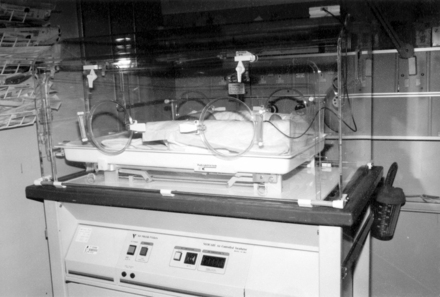Chapter 15 Incubator care
INTRODUCTION
The maintenance of a neutral thermal environment is of the utmost importance when nursing the pre-term, ill or cold infant. A neutral thermal environment is one which balances heat production and heat conservation and dissipation, thus enabling the infant to maintain a normal core temperature with minimal oxygen requirements and calorie expenditure (Amlung 1998).
The neutral thermal environment can be maintained in four main ways:
RATIONALE
Both term and pre-term infants have difficulty in maintaining body temperature owing to an inability to control their heat loss. A low admission temperature is an independent risk factor for morbidity and mortality in pre-term babies (Costeloe et al 2000). Prevention of heat loss in ill and distressed infants is crucial to their survival; thus the provision of a neutral thermal environment, when nursing the infant, is of the utmost importance (Amlung 1998). Environmental temperature, which maintains the infant’s skin temperature between 36.5 and 37.5°C (rectal 37°C) is known to promote minimal metabolic rate and oxygen consumption (Merenstein & Gardiner 2006). This is defined as the neutral thermal environment.
FACTORS TO NOTE
Infants are at risk of poor temperature control caused by an immature hypothalamus resulting in poor control of heat loss and heat production (see Ch. 29). This is more marked in the pre-term infant. Pre-term infants lack glycogen and stored fats, particularly brown fat which is important both as an energy source and for heat production. Brown fat is laid down in a variety of locations in the body between 26 and 28 weeks’ gestation; infants born before this time may lack the ability to generate their own heat. Infants who do have brown fat have the ability to generate heat from birth (Mance 2008). Brown fat in infants differs from that in adults in that it has a higher number of mitochondria and an abundant sympathetic nerve supply. Brown fat accounts for 10% of the term infant’s total adipose tissue (Flaherty 1996). Infants have a thin subcutaneous fat layer resulting in poor insulation (England 2003).
Term and pre-term infants do not have the ability to shiver to produce heat in response to cold and their metabolic response is limited. Changes in peripheral vascular tone, with constriction of skin vessels, occur in an attempt to reduce heat loss, thus keeping the blood in the central circulation. Non-shivering thermogenesis may occur where heat production is achieved from brown fat (Mance 2008). Heat loss in the infant is nearly four times greater, per unit of body weight, than in adults. This is primarily due to the higher ratio of surface area to body weight in infants (Lyon 2004).
Infants lose heat in four ways:
Stay updated, free articles. Join our Telegram channel

Full access? Get Clinical Tree



